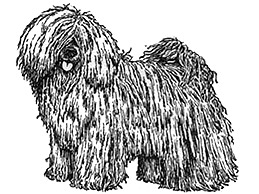Puli Breed Standard
Last updated: 19 Dec 2014
A breed standard is the guideline which describes the ideal characteristics, temperament, and appearance of a breed and ensures that the breed is fit for function with soundness essential. Breeders and judges should at all times be mindful of features which could be detrimental in any way to the health, welfare or soundness of this breed.

Name changed in Australia October 1995
Kennel Club (London) Standard, Revised 1987
Adopted in Australia 1 January 1998
-
Group:
Group 5 (Working Dogs)
-
History:
-
General Appearance:
Sturdy, muscular, wiry with fine bone. Whole well covered with long (according to age), profuse, corded coat. Long hair overshadows eyes like an umbrella. Viewed from side, trunk and limbs should present square figure.
-
Characteristics:
Herding dog, medium-sized, nimble and extremely intelligent.
-
Temperament:
Lively, wary of strangers but not displaying nervousness or unprovoked aggression.
-
Head And Skull:
Disregarding hair, head small and fine with slightly domed skull. From the front it appears round, from the side almost elliptical. Muzzle one-third length of head with well defined stop; not snipy but bluntly rounded. Arches of eye socket well defined, nose relatively large and black, eyerims and flews black in all colours.
-
Eyes:
Medium size, dark brown with lively expression.
-
Ears:
Set slightly below level of skull, V-shaped, pendant, of medium size, covered with long hair. Length of ears about half length of head. Ears do not appear noticeable, even when alert.
-
Mouth:
The roof uniformly dark, or variegated with deep pigmented spots on dark base. Flews tight and black. Tongue bright red. Jaws and teeth strong with perfect scissor bite, i.e. upper teeth closely overlapping lower teeth and set square to the jaws.
-
Neck:
Set at an angle of 45 degrees to horizontal; of medium length, tight skinned and muscular. When fully coated, neck appears to merge with body.
-
Forequarters:
Shoulders well laid. Elbows tight. Forelegs straight and muscular, and viewed from any angle, vertical.
-
Body:
Withers slightly higher than level of back which is medium length. Loin is short and broad, belly slightly tucked up. Ribs deep; rib cage broadening from behind elbows and well sprung. Rump short and slightly sloping but this is not obvious because of tightly curled tail.
-
Hindquarters:
Strong and well muscled. Pelvis forming an angle of 90 degrees with thighbone. Well bent stifle. Hocks set fairly low. When viewed from the rear, the legs should be parallel, with feet turning neither in nor out. Wide pelvis desirable, especially in bitches.
-
Feet:
Short, round, tight. Hindfeet slightly longer than forefeet. Nails strong, black or slate-grey. Pads are springy, dark grey in colour.
-
Tail:
Medium length, curled tightly over the rump-loin area; long hair of the tail mixes indistinguishably with similar hair of rump, so that tail does not appear separate.
-
Gait/Movement:
Stride is not far-reaching. Gallop short. Typical movement short-stepping, very quick, in harmony with lively disposition. Movement never heavy, lethargic or lumbering.
-
Coat:
Correct proportion of top and undercoat creates, naturally, the desired cords. Matting and felting to be avoided, and combed coat is as undesirable as a neglected one. Coat generally longest on hindquarters, shortest on head and feet. Some dogs will grow a floor-length coat.
-
Colour:
- Black, with or without intermingling of white hairs
- Black with rusty or grey shading
- Grey in various shades
- Fawn (known as ‘fako’ in its country of origin) preferably with a distinct black mask. All shades of fawn.
- Grey or fawn may have an intermingling of black or white hairs with black or grey tips on tail and ears.
- White without any yellow markings
The overall appearance of all variants must be that of a solid colour. A white patch at the forechest not exceeding 5cms (2ins) in diameter and a few white hairs on feet are permissible. Skin well pigmented, black or slate grey. Any colour or marking deviating from the above is undesirable.
-
Sizes:
Height:
Dogs - 40-44 cms (16-17.5 ins)
Bitches - 37-41 cms (14.5-16 ins)
Weight:
Dogs - 13-15 kgs (29-33 lbs)
Bitches - 10-13 kgs (22-28.5 lbs)
-
Faults:
Any departure from the foregoing points should be considered a fault and the seriousness with which the fault should be regarded should be in exact proportion to its degree and its effect upon the health and welfare of the dog.
-
Notes:
Male animals should have two apparently normal testicles fully descended into the scrotum.
 For owners
For owners
 Members
Members
 Dogs Australia is a not-for-profit organisation advocating for the preservation of purebred dogs through ethical breeding.
It champions the highest standard of animal welfare through education and fostering dog-loving communities.
Internationally recognised and established in 1958 as the Australian National Kennel Council (ANKC),
the organisation promotes responsible dog ownership; maintains the ORCHID* heritable canine diseases database;
funds research into canine diseases; and supports state and territory-based member bodies.
Dogs Australia promotes breed conformation shows and community sports for dogs that fulfil a breed’s natural instincts.
Dogs Australia is a not-for-profit organisation advocating for the preservation of purebred dogs through ethical breeding.
It champions the highest standard of animal welfare through education and fostering dog-loving communities.
Internationally recognised and established in 1958 as the Australian National Kennel Council (ANKC),
the organisation promotes responsible dog ownership; maintains the ORCHID* heritable canine diseases database;
funds research into canine diseases; and supports state and territory-based member bodies.
Dogs Australia promotes breed conformation shows and community sports for dogs that fulfil a breed’s natural instincts.







